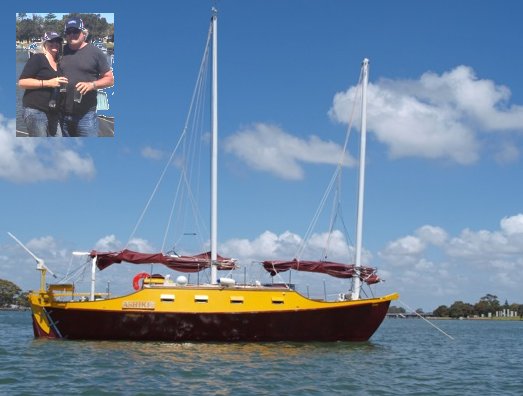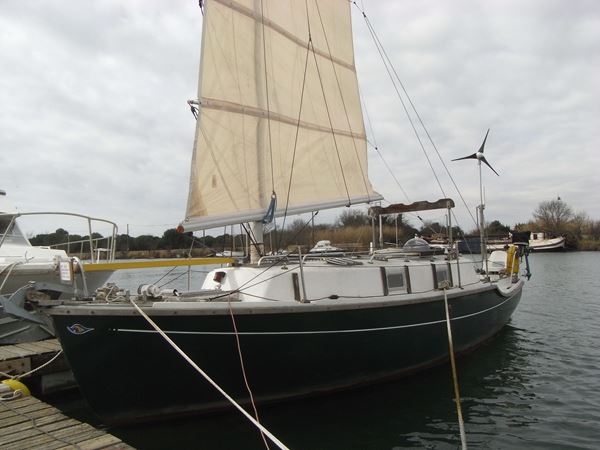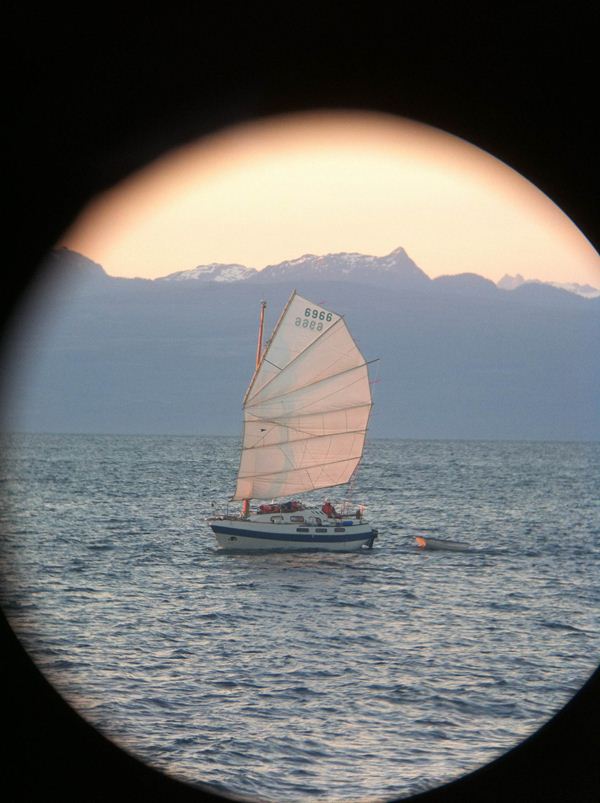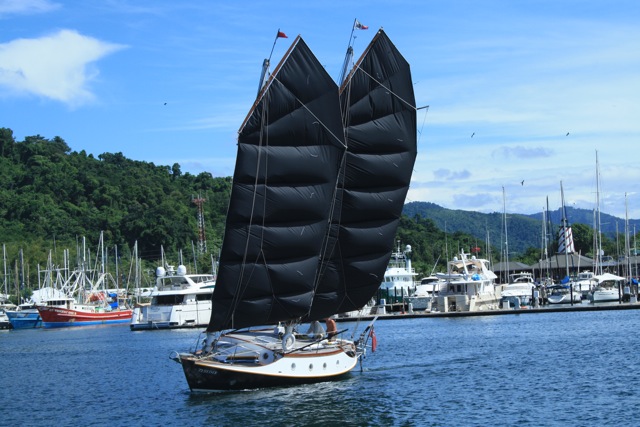.

The Junk Rig community features a wide range of boats, rigs and ideas. We like to showcase one boat on a regular basis and are interested in hearing from any members who would be prepared to share some photos and details of their pride and joy.
 Usually we wait for a sailing shot, but this month we've bent the rules to make Ashiki our Christmas 'Boat of the Month'. Six years ago Gary and Susan King decided that some day they wanted to cruise SE Asia - and they still do. But why did they choose to build rather than buy? Gary says:
Usually we wait for a sailing shot, but this month we've bent the rules to make Ashiki our Christmas 'Boat of the Month'. Six years ago Gary and Susan King decided that some day they wanted to cruise SE Asia - and they still do. But why did they choose to build rather than buy? Gary says:
"At that time the market for cheaper boats didn't really exist in Western Australia, so we settled on a 'Badger', partly because of Annie's book, and partly for it being an easy build. I didn't want to work with either steel or pure fibreglass, so plywood it was. Ashiki was constructed in our backyard, and took 5½ years to complete. We launched her in October this year in Mandurah. Since the launch we've sold the car, liquidated our 'stuff' in garage sales, quit the house and moved aboard. I have office space onboard (the nav station), so continue to work while afloat. So far Ashiki has only sailed about 30 nm, because most the time we've been completing projects on her. We look forward to some local cruising this summer."
A great story, Gary, and thanks for responding so fast to our request for it - and for launching the dinghy for the first time to take this image! Couples that build put their hearts and souls into it, and you two clearly have. Congratulations.
November 2013 - Paul McKay's Miranda
 JRA members enjoy experimenting with their rigs. Over the years we've seen flat Hasler/ McLeod style sails, Arne Kverneland's aerofoils with built-in camber, fanned rigs like Annie Hill's Tyler-inspired Fantail, 'split junks' from Slieve McGalliard... Each has positives and negatives, advocates and nay sayers, but they all work fine for their owners. They're all, as Kurt Jon Ulmer keeps saying, "Good enough".
JRA members enjoy experimenting with their rigs. Over the years we've seen flat Hasler/ McLeod style sails, Arne Kverneland's aerofoils with built-in camber, fanned rigs like Annie Hill's Tyler-inspired Fantail, 'split junks' from Slieve McGalliard... Each has positives and negatives, advocates and nay sayers, but they all work fine for their owners. They're all, as Kurt Jon Ulmer keeps saying, "Good enough".
Every so often something unique turns up, and this year it was Paul McKay's 1986 Etap 23 lifting-keel sloop Miranda, with her new rig. He chose the perfect summer for his experiments, long periods of benign, sunny weather with winds often between 5 and 10 knots, "Perfect for testing a rig that I had no idea how it would work".
From a distance and with dozy eyes you might think the main is a Freedom rig, given its pronounced roach. Look more closely and you see that, like some Freedoms, the battens encompass the sails, but not in the same way that Freedoms' wraparound wishbones did. Is it a wingsail? It has battens like a junk, and the picture shows it reefs like one. Most junks don't have a foresail - is it attached to the mast?
Paul calls his design an Aerojunk which seems apt. Whatever, it's an inspired and fine design which is performing well. Paul's aim is to produce a "docile, safe, efficient and fast cruiser", and he seems to be getting there, though he says, "Experimentation is hard work!"
Further pictures of Paul's experiments are in our Photo Gallery, and his latest report is in Magazine 63, which members can download.
October 2103 - Chris Gallienne's Colvic Sea Rover China Girl
 Chris says: "China Girl was moored at Agde on the French Mediterranean coast when I found her on eBay at a near give-away price. Early on 7th August my son Ben and I motored her into the famous Round Lock, the entrance to the canal. After a fascinating 310 nm trip through the ‘Canal des Deux Mers’, the river Garonne and the Gironde Estuary - pausing at Paulliac to raise the mast - we set sail from Royan on the 19th, bound for Plymouth via Ile de Yeu, Audierne, the Raz du Sein and the Chenal du Four, 400 nm sailing. We arrived in Plymouth Sound on Monday 26th, after an exciting and educational three week trip - one for each keel. She appears to have always been owned by JRA members, originally as Three Sisters (Chinese lug main/sprit mizzen) including W. A. King-Webster in Dumfries and Galloway (see JRA Newsletters 1, 3 & 27), who also once had a Kingfisher 26 schooner junk. She is now a junk sloop with the mast moved further aft, and hinged battens providing camber. She sails pretty well on all points, but is under-canvassed, has considerable weather helm and I don't like the hinged battens. I plan to convert her to a split junk sail."
Chris says: "China Girl was moored at Agde on the French Mediterranean coast when I found her on eBay at a near give-away price. Early on 7th August my son Ben and I motored her into the famous Round Lock, the entrance to the canal. After a fascinating 310 nm trip through the ‘Canal des Deux Mers’, the river Garonne and the Gironde Estuary - pausing at Paulliac to raise the mast - we set sail from Royan on the 19th, bound for Plymouth via Ile de Yeu, Audierne, the Raz du Sein and the Chenal du Four, 400 nm sailing. We arrived in Plymouth Sound on Monday 26th, after an exciting and educational three week trip - one for each keel. She appears to have always been owned by JRA members, originally as Three Sisters (Chinese lug main/sprit mizzen) including W. A. King-Webster in Dumfries and Galloway (see JRA Newsletters 1, 3 & 27), who also once had a Kingfisher 26 schooner junk. She is now a junk sloop with the mast moved further aft, and hinged battens providing camber. She sails pretty well on all points, but is under-canvassed, has considerable weather helm and I don't like the hinged battens. I plan to convert her to a split junk sail."September 2103
We were delighted to make Karlis Kalnins' newly-converted Otterbelly - a 1974 Bayliner Bucaneer - our star 
boat this month. Karlis says: "She is a roomy, inexpensive (and often derided) fibreglass sloop design I purchased in 2011 for the purpose of a junk rig conversion, as it was a boat I wouldn't mind cutting big (and possibly misplaced) holes in. The name Otterbelly popped into my head soon after I bought her. It was cute and seemed to convey the right sense of playfulness - sea otters float well and the young ride on parents' bellies, so it also sounds seaworthy and secure.

boat this month. Karlis says: "She is a roomy, inexpensive (and often derided) fibreglass sloop design I purchased in 2011 for the purpose of a junk rig conversion, as it was a boat I wouldn't mind cutting big (and possibly misplaced) holes in. The name Otterbelly popped into my head soon after I bought her. It was cute and seemed to convey the right sense of playfulness - sea otters float well and the young ride on parents' bellies, so it also sounds seaworthy and secure.
"The cat-junk rig is based on Arne Keverneland's Johanna rig (pdf download link), scaled, with one less lower panel and a chopped peak - about 30 sq m of sail. Arne's CPJR writings were used as a practical guide and supplement to the theory in Practical Junk Rig. The mast is a hollow 6-staved birds-mouth (link to pdf by Gary Pick) of lumber-grade douglas fir, and took most of the time and effort of the 2-year conversion process on Gabriola island, British Columbia. It's a little heavy for the boat judging by the new waterline; if I started again I would use the aluminum/wooden topmast method as described lately by Annie Hill and Arne. The sails are dacron cut from two old genoas, and the battens are leftover wood (douglas fir and common spruce) from the mast construction. These will be replaced as as time permits or as required. For the sewing work I rebuilt a few machines from the local recycling depot before settling on a simple all-metal white zig-zag with a new 1.5 amp alphase motor.
"Otterbelly is currently on a maiden cruise from Gabriola up to Cortez to work out the finer points of the new rigging. By 'working out' I mean slipping some sheetlet and lazyjack knots and dumping the rig into the rolling F5 sea, breaking some battens, and reconfiguring the throat hauling parrel. A secondary aim of the mission is 'junk hunting' (sorry, Lesley), explaining the merits of cambered panels and the benefits of JRA membership to wayward junk rig owners I encounter.
"When I settle somewhere for the rainy season here (which has actually been prematurely upon us this week) I'm hoping to have a full report of the build for a future issue of the JRA magazine."
August 2013
After a gruelling 5 months of fiberglass grinding, interior structural reconfiguring, and cutting very large holes in an otherwise perfectly fine deck, Daniel Collins hoisted Aletheia's junk sails for the first time in June 2013, for a quick jaunt up and down the Ashley River in Charleston, SC. Aletheia, named after the Greek goddess of discovery and revelation, is an Allied Princess 36' (11m) fiberglass boat first launched in 1978. Originally a ketch rig, Daniel converted her to junk after a devastating dismasting 250 nm offshore enroute to Bermuda.
The schooner rig was designed by Tad Roberts, of Gabriola Island, BC, to complement the stout Princess hull with its cutaway full keel and shallow 4.5' (1.4m) draft. To move the 16,000 lb (7.25 metric ton) hull smoothly through the water, Tad specified nearly 660 square feet (61 sq. m) of sail area in two nearly equal-sized sails. The masts are aluminum streetlamp poles and are unstayed, although running backstays are fitted for belt-and-suspenders reliability in a rough sea or when flying staysails.
Daniel performed all of the construction, including sewing the sails, in a marina slip in just five months. The masts were prepared offsite and a welder's assistance was used to make the partners and masthead fittings, then stepped at a marina with dockside hoists. The full saga of the reconstruction is on Daniel's website and in JRA Mag. #62.
Sea trials are planned as a series of short coastal hops northwards along the US East Coast this summer, with a 'floating junket' taking place in
the various ports Daniel visits. Click here to find out when and where Daniel plans to be if you want to visit his boat or bring your junk rig alongside for an impromptu junket in your area: sign up via the Rallies and Junkets box below. Daniel plans to takeAletheia to Halifax, NS by the end of summer, to winter there, and to continue onwards next season.
July 2013 - Peter Manning's Malliemac
 Peter Manning waited ages for his first sail in Malliemac, and so have we, so as it's his birthday today, July 1st, here she is! Mallie was launched at Preston Marina, UK, in February 2013 and enjoyed her maiden voyage at the end of May.
Peter Manning waited ages for his first sail in Malliemac, and so have we, so as it's his birthday today, July 1st, here she is! Mallie was launched at Preston Marina, UK, in February 2013 and enjoyed her maiden voyage at the end of May.Mallie is the sister ship to David Tyler's Tystie (now in Alaska). The design and interior layout was conceived by David who asked designer David Thomas to wrap a nice hull around it: he certainly did that.
Both boats are shoal draft with internal ballast and lifting bilge boards, in Tystie's case hinged whilst Mallie's move vertically. Although her hull, deck and coach roof were professionally built, she was fitted out and equipped by Peter. Tystie has an open plan layout, but Mallie has a separate port side double forecabin. Both are intended for long distance cruising. Further sea trials will be undertaken during the summer when Peter and crew may be found cruising around the Irish sea. They hope to attend a North Wales or Kippford junket (whichever is chosen) at the end of August or early September.
La Chica is a much modified Tahitiana (a Weston Farmer design in turn based on John  Hanna's Tahiti Ketch). Built by her owner Paul Thompson in 1989, she has been cruised extensively and has gone through three rig changes, the last being to a junk rig schooner.
Hanna's Tahiti Ketch). Built by her owner Paul Thompson in 1989, she has been cruised extensively and has gone through three rig changes, the last being to a junk rig schooner.
After an extensive refit La Chica was re-launched in March. She is now being prepared for a single handed non-stop circumnavigation. More info can be found at thttp://SailingWithoutaSound.com. The site is, Paul says, sadly out of date (a new one is imminent) but the story and details are current. When the circumnavigation will commence is not yet fixed as Paul is trying to find a major sponsor so as to enable broadband coverage from the boat. However the weather window opens in October and effectively closes at the end of November so if he does not make it this year, it will be in the next.
Read Annie Hill's article about the launch here.

Bertrand and Marie-Hellene Fercot launched self-built Grand PHA, a Wharram Tiki 46, in September 2012 in Moulin Blanc Marina, Brest (Brittany, West France). Grand Pha now has (see their blog, many other pictures), a side-by-side Gallant-style rig with non-articulating aluminium wishbones, all sheeted. She weighs 9 tons including her diesel and electric engines!
The Fercot's made it to the Lymington 'junket' (mini-rally, report to come) for the recent AGM, and were kind enough to give some lucky members a sail, even though they were leaving the next day for Portugal and beyond. We wished them a safe trip after a long winter: a month on the mud in l'Aberwrac'h, followed by a brief sojourn in the new Roscoff marina and four months in the new Marina du Chateau of Brest and two weeks in the Rade de Brest at anchor waiting for good weather to sail to the Isle of Wight. They arrived in Culatra, Portugal after 15 days. (Picture: Gerry O'Brien.)
 JRA Secretary Edward Hooper emailed recently to say, "I'm trying a HK parrel on the creased top main panel, It is on the aft 60%. I think it is almost working OK, though I may have it a bit too tight. I also need to smooth the sails along the battens. Had a great sail today until the fog came down very thick, and I had to work my way back from outside the East Hook buoy purely on DR, no echo sounder, no GPS, just aiming from one buoy to where the next ought to be. A little bit anxious for a while!"
JRA Secretary Edward Hooper emailed recently to say, "I'm trying a HK parrel on the creased top main panel, It is on the aft 60%. I think it is almost working OK, though I may have it a bit too tight. I also need to smooth the sails along the battens. Had a great sail today until the fog came down very thick, and I had to work my way back from outside the East Hook buoy purely on DR, no echo sounder, no GPS, just aiming from one buoy to where the next ought to be. A little bit anxious for a while!"
Amiina is a Van de Stadt Splinter 21 with a split junk rig designed by Slieve McGalliard, based in Poole, UK. Edward says, "My 220 sq.ft. sails were built by Rod Brown of Quay Sails. They are actually quite experimental. We deliberately made all 5 'main panels' and all 5 'jib panels' identical, so Rod only had to cut 3 patterns: 1 x main; 1 x jib and 1 x topsail. Battens are attached with cable ties through holes burnt in the seam/tape joint - no pockets or eyelets."
Rod also built Tim McCloy's new sail on China Blue, which enabled him to win first small boat to the Azores in last year's Azores Jester Challenge.

Vanharouva is a 6m (20 ft) grp Havsfidra class double-ender, designed by Lage Eklund, built at Fisksätra varv, Sweden, in 1972, and converted to junk rig in July 2012 by Robin. He made the 25 m2 shelf-foot sail and lashed it to the yard and boom, with battens in pockets.
Robin has been sailing since he was 5, mostly in the gulf of Finland but now and then across the Baltic and along Denmark's west coast. Vanharouva's home port is Lovisa, Finland. Members can see more pictures in his photo albums. He's now building a slightly bigger boat for live-aboard cruising.
On learning that Vanharouva was BOTM Robin emailed to say, "I feel honoured and flattered and would like to tell you one of the reasons I converted to junk. In 2009 I got Parkinsons Disease, then in 2010 a spinal infection nearly cost me my life and left me with nerve damage in my feet. If I wanted to continue sailing I had to do something. The conversion to junk and last year's sailing experiences in Vanharouva kick-started an interest in developing sailing for the disabled. Nearly all my life I've done amateur boat design so I intend to use Vanharouva as a lab. for developments in this direction. In fact right now feels like the time to start writing about this. I'll post on a forum soon."
February 2013 - Pete Hill's Oryx
Well it took a while to squeeze some pictures out of busy Pete Hill of Badger fame, but here at last is one, and there are more. Pete says, "Oryx is a modified Bernd Kohler KD860. The main alteration I made to the design was to lengthen her from 8.6 metres to 10 and, of course, rig her as a side-by-side split junk sail. I got the idea from Poppy's rig and much help from her owner and rig designer Slieve McGalliard. Instead of bulging panels I made half wish-booms with the sail loose-footed and attached to each batten only at the luff and leech. The 'jiblets' are set on hinged 'boomlets', again loose-footed. The rig works very well. She took 2 years to build, largely single-handed, and cost a little over £20,000, my labour being free. She's our cruising home and is very comfortable at sea and in harbour and as soon as I sort out a slight weather helm problem she'll be a great boat." The pic was taken in Plymouth Sound, before she headed south. Where are you now, Pete?
January 2013 - Alan Martienssen's Zebedee
Here's an extract from Alan Martienssen's article published in our magazine, issue 61, February 2013. "Chaguaramas, Trinidad. It’s amazing how much time we spend tacking, so we wanted better performance and Arne’s 'Amateur Method B' seemed the way to go. We went for 10% camber in the lower panels, reducing to 4% then 1% in the triangular ones. Slieve very kindly provided the camber figures. It took us 5 days to build both sails. We fitted throat hauling and Hong Kong parrels. So far we’ve done 3 days sailing in very light winds with gusts up to about F5. The difference is spectacular with regard to speed, but we’ve more to learn about tacking angles. We certainly make to weather faster, and we no longer miss stays, but we have to
sheet the main in much more. There are no major creases and
the pressure on the battens is fine!". Zebedee is a Benford Dory 34.
the pressure on the battens is fine!". Zebedee is a Benford Dory 34.
CURRENT BOTM 2016 BOTM 2015 BOTM 2014 BOTM 2012 BOTM 2010-11


